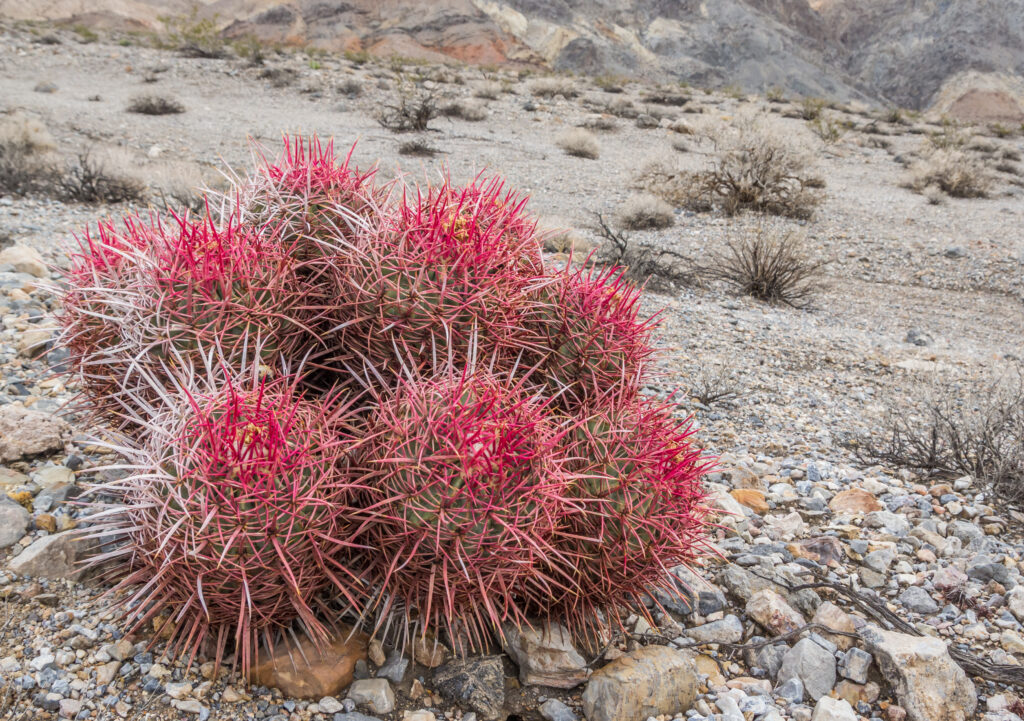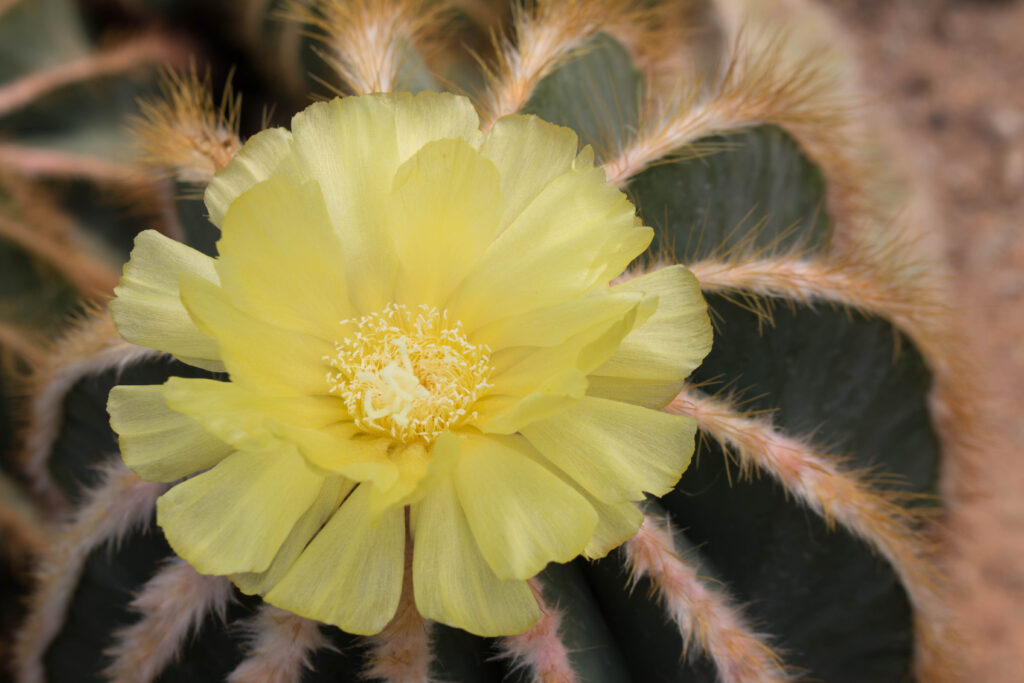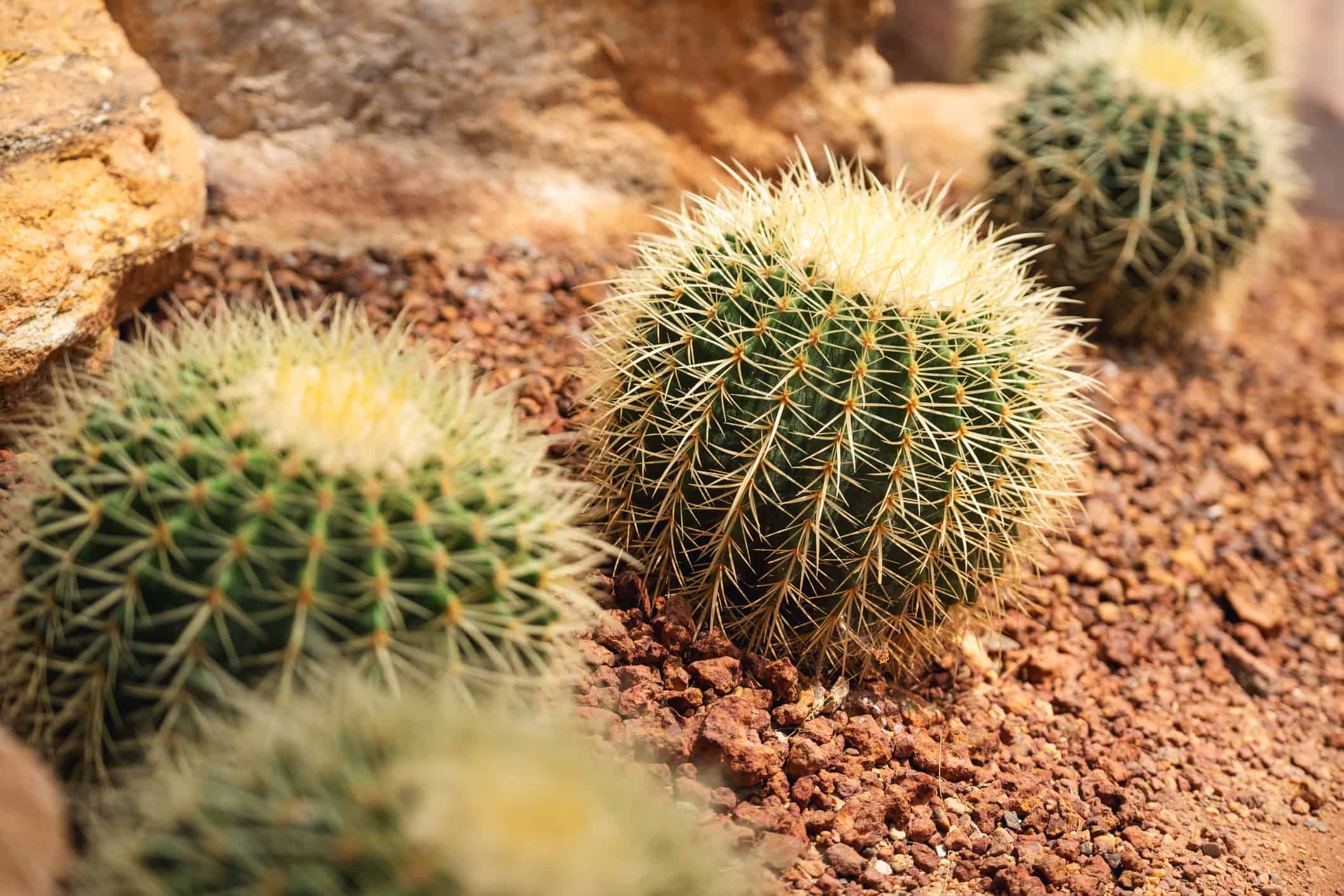Even if you don’t live in the desert, you’ve probably seen a barrel cactus at some point. They are as identifiable as saguaro cacti as symbols of the desert, and they are kept as houseplants worldwide.
Barrel cactus plants have a ribbed, rounded form that distinguishes them from other types of cacti or succulents. The barrel cactus is a fantastic plant for novice gardeners since it requires very little maintenance. However, it does require a bit of patience: It can take many years for the barrel cactus to reach maturity. This cactus naturally thrives in soil that is nutrient-poor. As a result, many plant parents choose to grow this particular kind of cactus in drier, hotter areas of the United States because they can survive a lot of neglect and poor soil.
In this guide, we’ll explore a ton of interesting information about barrel cacti. We’ll also explain how you can grow your own barrel cactus at home.
What is a Barrel Cactus?
The many species of barrel cacti, which are native to the deserts of southwestern North America and north central Mexico, belong to the two genera Echinocactus and Ferocactus. The Ferrocactus is fiercely thorned, whereas the Echinocactus has a fuzzy crown of fine spines. Each one makes appealing complements to a succulent arrangement and can be grown as a houseplant or in an arid garden. One of the most popular species for use as a houseplant or landscaping plant is Echinocactus grusonii or the golden barrel cactus.
Anatomy of the Barrel Cactus
Although they are nearly perfectly round when they are young, the cactus is known as a barrel cactus due to its oblong shape. They have deep ribbed lobes and stunning rows of neatly placed spines. They often extend out as they mature, making them more oval than round.
When completely grown, this cactus may grow up to six feet tall, making it a quite large cactus species. A fully developed specimen can cost hundreds of dollars to acquire at that size as it takes over a decade to mature. Miniature indoor specimens can stay manageable for many years before growing too big since they grow so slowly.
Depending on the age of the plant and the species, the ribs of this cactus are numerous and distinct. The spines are lengthy and their colors can range from yellow to brown to red. Only after at least a decade do flowers start to grow at the top of the plant, if at all. The barrel cactus has a lifespan of more than 100 years.
Typically, barrel cactus buds begin to bloom in April and give forth a vibrant yellow or orange flower. There are also red and pink variations. However, these are less common. Just the tip top of the shrub can grow flowers. Early in May, the blossoms may become a different hue as they start to wilt.
Little fruit in the shape of pineapples will develop as the flowers fade. The fruit has been reported to survive a whole year if left untouched. The fruit can be easily removed for this cactus, but because it is quite bitter-tasting and dry, it isn’t that popular as a source of food.

Barrel cacti (pictured) can either have very sharp and prominent spikes or very small, almost fuzzy spikes.
©Marc Venema/Shutterstock.com
Barrel Cacti Native Environment
This cactus is a native of Mexico and the southwest region of North America. The Sonoran Desert is home to some of the biggest specimens. They can grow anywhere, so long as the region is in USDA hardiness zones 10 through 11.
Uses for Barrel Cacti
Plant nurseries grow barrel cacti as decorative plants. They are regarded as quite simple and easy to grow, though they are slow growers that take a while to reach large sizes. They can generate rounded offshoots as well, making them popular houseplants for those who enjoy propagating their plants.
The fruit of this type of cactus was historically gathered by Native American peoples as a last-resort source of water during severe droughts. The cactus’ flesh is candied and consumed as a dessert in Mexico.
Because many barrel cacti species tend to lean towards the southwestern sun, they can be useful for hikers and travelers who are lost in the Sonoran Desert.
Barrel Cacti Varieties and Subspecies
Echinocactus grusonii is a very popular species of barrel cactus. The species Echinocactus horizonthalonius is another species known as the devil’s head cactus due to its notably massive, sharp spikes. Another species, Echinocactus parryi, playfully known as the horse crippler cactus, is an even more painful species that you’ll want to avoid. However, this species is only found in the remote desert of Chihuahua, Mexico.
Ferocactus echidne is another species, known as the Sonoran barrel cactus, that is commonly found throughout Mexico. The species Ferocactus hamatacanthus is found in the southern United States that is known for its barrel shape and beautiful yellow blooms. Ferocactus cylindraceus is a tall type of cactus with downward-curving spines and yellow blooms, often known as the California barrel cactus, desert barrel, or miner’s compass. The fishhook cactus, also known as Ferocactus wislizenii, produces blooms that are more vibrant than those of other cactus species.
Colors of the Barrel Cactus
Barrel cacti can range from grey to light green to deep forest green. Their spines are often white or cream in color, though some can be yellow and brown. The colors of these cacti depend on their species, of which there are quite a few. Barrel cactus flowers are rare but can take on yellow, orange, red, and pink hues.
What Will Make My Barrel Cactus Bloom?
The barrel cactus must be at least 15 years old to bloom. Just as well, its environment must mimic its native environment under optimal growing circumstances in order to bloom indoors. Unfortunately, this happens very rarely for houseplant specimens. However, flowers do appear in the spring or summer if it chooses to bloom.
Making sure your cactus has full sun exposure during its growing season is the key to getting it to bloom. In order to promote blooms from April to September, it also requires a phosphorus-rich fertilizer that is applied at least once a month.

Barrel cacti flowers (pictured) can be difficult to get to grow on indoor specimens, but it is certainly not impossible.
©Wonderplay/Shutterstock.com
How to Grow a Barrel Cactus
Around six species of barrel cacti, including the golden barrel cacti, are included in the genus Echinocactus and are indigenous to Mexico and the southwestern United States. Over 30 distinct species of barrel cacti, distinguished by their big spikes, are found in the Ferocactus genus.
These cacti are genuine desert plants. As they develop, they cannot tolerate standing water. Put your cactus in potting soil or dirt from outside that drains very well. These plants require the brightest, sunniest site you have available when cultivated indoors.
Although they are capable of producing blooms, they typically won’t begin to do so until they are at least six inches wide, which might take up to 15 years or even longer. In the spring or summer, the barrel cacti’s blooms reach a width of approximately two to three inches and develop near the top of the barrel for two to six weeks.
Remember to hold off on watering for a while before the growing season. This “simulated drought” stimulates its wild growth cycle, which can encourage it to grow a bit faster, bloom, and even grow fruit. If it grows indoors, water it once a week to promote blooming. This plant requires well-draining soil since wet soil can cause root rot, which might cause the plant to die.
Propagating a Barrel Cactus
Barrel cacti can be grown from seed or via propagation of offshoots. Growing barrel cactus from seed is simple. Commercial cactus mix should be poured onto a seed-starting tray before seeds are planted on the soil’s surface. After uniformly misting the soil, sprinkle a little coating of sand on top of the seeds. Keep the tray in a warm area and cover it with a lid or plastic wrap.
The seeds will sprout pretty quickly if they are viable. Once the sprouts are big enough, they can be moved to a bigger container. Always use gloves while working with barrel cacti since they have unpleasant spines, which can be hard to see when they are young in some species.
Another option is to propagate via offshoots or pups. The base of barrel cacti can produce small baby plants that will stay attached to the parent plant until ready to sprout roots in the nearby soil. A sharp knife should next be used to slice the baby plant away from the parent plant after removing the surrounding soil.
After letting the offshoot rest for a day to allow the wound to heal and develop a thin callus, place the specimen in a pot with coarse cactus-mix potting soil. Water the young plant right away, but only until its roots have begun to develop. From there, it can be planted and cared for like any other cactus.
Repotting and Transplanting a Barrel Cactus
Every several years, you should repot your barrel cactus. Repotting is best done early in the growing season or in the summer. To repot this cactus, make sure the soil is completely dry, and then carefully remove the plant from the pot while protecting yourself by donning heavy spike-proof gloves. Take out any rotting or dead roots as you remove the old soil from the roots.
As you repot the plant, spread the roots out in the new pot and backfill with a potting mixture made specifically for cacti. To lower the risk of root rot, let the plant dry out for a week before starting to water it.
Try not to repot your barrel cactus too often. It isn’t really necessary, as the barrel cactus grows so slowly. It can also stress out the plant.

Potted cacti (pictured) need occasional repotting, but not too often.
©iStock.com/AnSyvanych
Pruning a Barrel Cactus
Pruning the barrel cactus is not necessary when it comes to aesthetics. You can remove dead branches and blooms to allow the plant to focus its resources on nutrient-rich growth. Cut a portion off at the joint with a sharp knife or disinfected pruning shears. Just as well, diseased portions of the cactus can be pruned off to potentially save the whole plant. However, this usually does not work very well, as the round and often large cactus has trouble healing wounds very quickly. In general, we recommend simply leaving the barrel cactus alone.
Water Needs for Barrel Cacti
The roots of barrel cacti are prone to decay. Water sparingly every month or two from fall through spring, and make sure the soil drains thoroughly. Never let the barrel cactus sit in water or leave any water in the watering tray underneath your potted cactus.
Simulate a drought in the winter by withholding water. Provide water gradually starting in the early spring, increasing it to once a week in the spring and summer. Make sure the water drains completely and empty the water tray to ensure your cactus does not sit in too much moisture.
Sunlight Needs for Barrel Cacti
The optimum location for this cactus is a bright window with direct sunlight. Ideally, this should be one that faces south. Lack of sunshine will cause these plants to develop slowly and struggle to survive.
Soil Needs for Barrel Cacti
This plant requires dry, extremely well-draining soil in order to be grown outside. The best soil for cacti is a mix that drains quickly, rather than a mix that is nutrient-rich. If you use a normal peat-based mixture, improve the drainage by adding more perlite or sand. As the soil starts to degrade, repot the plant with fresh well-draining soil. Add a few inches of gravel or clay balls to the pot’s bottom to promote drainage.
Fertilizer Needs for Barrel Cacti
You can fertilize this cactus with phosphorous-rich fertilizer in spring or summer to encourage flowers. Some growers will use a basic low-nitrogen cacti fertilizer every month or so to encourage growth. However, this type of cactus is known for surviving even in the most nutrient-deficient soils. Fertilizer is not necessary but can be helpful for giving your cactus a growth boost.
Temperature and Humidity Needs for Barrel Cacti
As mentioned earlier, barrel cacti can be grown outside in USDA hardiness zones 10 through 11. While it prefers warm weather, this cactus can survive in temperatures as low as 40 degrees F. Ideally, these cacti species should be kept in a temperature range of 50 to 70 degrees F. Barrel cacti do not need any humidity and tend to do well without it.
Pests and Diseases to Watch Out For
Barrel cacti rarely have issues. However, on occasion, they could get scale or mealybug infestations. The best treatment is a water spritz followed by an insecticidal soap wash.
Pythium rot is one of the more difficult cactus diseases to treat. It might be hard to see before it’s too late to preserve the cactus, and it most often affects barrel cacti. Pythium rot symptoms typically originate in the roots and appear at the soil level. As a result of most of the damage being underground, it is one of the more difficult barrel cactus illnesses to identify.
To make matters worse, the pathogen is a host in the soil. The cactus will undoubtedly develop poorly if the soil is contaminated. Pythium rot cannot be treated effectively, but it can be prevented to some extent. In general, this disease can be avoided by not planting the cactus too deep and managing any cuts by keeping the area dry until it can form a callus.
Barrel cacti are fun little plants that can be kept at very manageable sizes for a very long time due to their slow growing rate. They look very cool, and it doesn’t keep much to keep them alive! What’s stopping you from giving this interesting-looking houseplant a try?
Thank you for reading! Have some feedback for us? Contact the AZ Animals editorial team.








